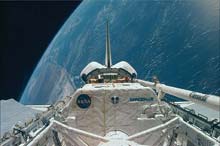
Two University of York graduates have found and preserved the giant tusk of the largest elephant fossil of its type ever to be found in the Middle East.
The tusk, two-and-a-half metres long and thought to be between six and eight million years old, was discovered by Dr Mark Beech, who finished his PhD at York recently and is now senior resident archaeologist for the Abu Dhabi Islands Archaeological Survey (ADIAS).
Mark discovered the tusk in Abu Dhabi’s Western Region last October

European scientists will be ‘turning off’ the effects of gravity during the STS-107 Space Shuttle research mission this month in order to gain a better understanding of processes in medicine, technology and science.
Their investigations will be among some 80 experiments performed during a 16-day mission in Earth orbit to be launched from Cape Canaveral tomorrow.
Seven of the 31 payloads are sponsored by ESA, and the crew will work 24 hours a day in two alternating shifts on experi

Important goal achieved in potential animal-to-human organ transplantation
In a session today at the annual meeting of the International Embryo Transfer Society (IETS), Randall Prather, Ph.D., Distinguished Professor of Reproductive Biotechnology at the University of Missouri-Columbia, announced the successful cloning of the first miniature swine with both copies of a specific gene “knocked out” of its DNA. The ultimate goal of this research, which is being conducted in partnership wi

A research team led by Johns Hopkins scientists has discovered that a special, tiny group of cells at the back of the eye help tell the brain how much light there is, causing the pupil to get bigger or smaller. The findings, which appeared in the Jan. 10 issue of Science, largely complete the picture of how light levels are detected in the eye.
“This tiny group of cells, together with rods and cones, are the bulk of the eye’s mechanisms for detecting levels of light and passing that in

Scientists at The Scripps Research Institute (TSRI) report in an upcoming article in the Journal of the American Chemical Society their synthesis of a form of the bacterium Escherichia coli with a genetic code that uses 21 basic amino acid building blocks to synthesize proteins–instead of the 20 found in nature.
This is the first time that anyone has created a completely autonomous organism that uses 21 amino acids and has the metabolic machinery to build those amino acids.
“We

Climate change had little to do with the demise of the dinosaurs, but the last million years before their extinction had a complex pattern of warming and cooling events that are important to our understanding of the end of their reign, according to geologists.
“The terrestrial paleoclimate record near the K-T is historically contradictory and poorly resolved,” says Dr. Peter Wilf, assistant professor of geosciences at Penn State. “In contrast, the resolution of K-T marine climates that has

Quantum defects have the potential to act as ultra-sensitive sensors that could offer new kinds of navigation or biological sensor technology. One type of these defect systems, nitrogen vacancy (NV)…

Breakthrough non-invasive technology for imaging through scattering media. Researchers introduce image-guided computational holographic wavefront shaping, offering fast and versatile solutions for complex imaging challenges. New study introduces a novel computational…

Modern astronomy has clung to the belief that the relativistic outflows or jets responsible for the existence of electromagnetic radiation of particularly high energies are located in the nuclei of…

In a pilot study, researchers at the University of Zurich have used artificial intelligence to detect antibiotic resistance in bacteria for the first time. This is an important first step…

New Method for Measuring Luminescence Lifetime. Researchers at the Max Planck Institute for Marine Microbiology, Leibniz-Institute for Baltic Sea Research and University of Copenhagen introduce an innovative approach to image…

UFZ study demonstrates for the first time the toxicological relevance of chemical mixtures as they occur in humans. “In our everyday lives, we are exposed to a wide variety of…

… and thermal post-treatment of flexible ultra-thin glass. Ultra-thin glass offers great potential for modern high-tech applications. Despite its superior properties compared to polymer films, the material has not yet…

Conventional catalysts for hydrogen production via water electrolysis usually contain precious metals and are expensive. However, cheaper alternatives have been developed, for example cobalt-manganese catalysts. They have a high activity…

The European Commission’s targets are ambitious: the ReFuelEU Aviation Regulation stipulates a 60 percent reduction in CO₂ emissions from aviation by 2050 compared to 1990 levels. A comprehensive EU Space…

New photonic computing method uses electromagnetic waves to solve partial differential equations rapidly. In the fields of physics, mathematics, and engineering, partial differential equations (PDEs) are essential for modeling various…

Neuroscientists show how fine motor skills of neural prostheses can be improved. Researchers at the German Primate Center – Leibniz Institute for Primate Research in Göttingen have developed a novel…

The TUM and the Pfennigparade Foundation have started a three-year research collaboration. The research will focus on the potential of robotics and AI-based technologies to help people with motor disabilities…